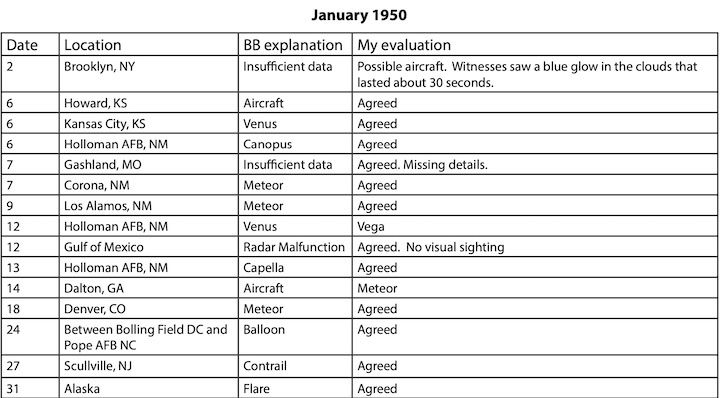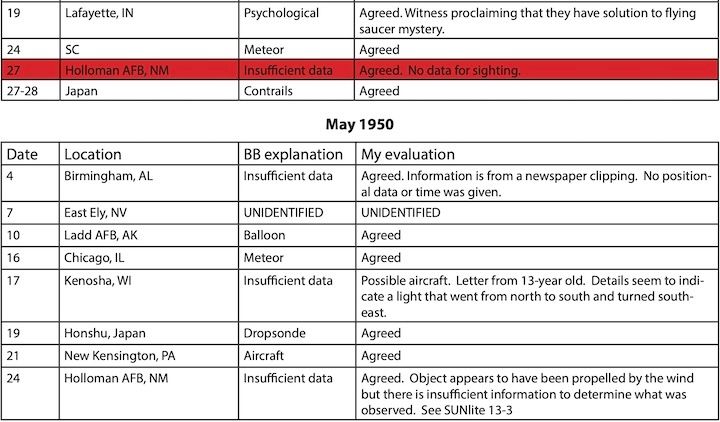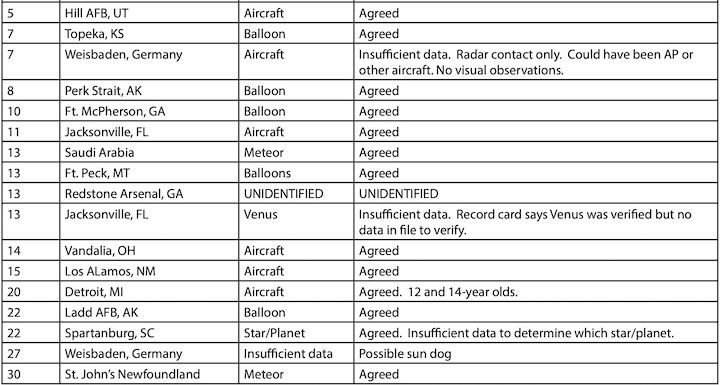6.07.2024

Project Blue Book case review: 1950
This is the latest edition of the Project Blue Book case review covering the year 1950. Like the previous evaluations, I tried to examine each case to see if the conclusion had merit. I added comments to help clarify the explanation or if I felt it was not correct or adequate. Items marked with red highlighting had photographs in the case file.
















Summary
The reports from 1950 proved to be interesting but the amount of investigations seem to have dropped off. The reports in 1949 appeared to contain a lot of information but those in 1950 were lacking in details. Some of the cases are nothing more than newspaper clippings or letters written to the project. At this point, the USAF appears to have given up and were merely collecting reports.
The most interesting case to me was the Datil, New Mexico case of February 24. It included some photographs and Blue Book labeled it as a comet in 1965. It is not clear what it was labeled as in 1950 but it probably was unidentified. The staff in 1965 drew their conclusion by comparing one of the photographs with an actual picture of a comet. Unfortunately, there was no comet of significant magnitude visible at the time. Only one photograph showed this “effect”. The others appeared to show a bright point source that displayed movement due to a hand held photograph with a exposure time of a second or two. The witness failed to provide any details about the sighting that could help identify what they photographed. We did get an elevation angle and course but azimuth/direction were missing. Was it in the South, North, East, or West? Additionally, while the camera was listed (an A5 sineflex with 8-inch lens? It is not clear in the case file), there was no indication of the film used, f-stop setting, and exposure times. To me, the photographs, while not very clear, looked like a point source, or object with small angular size, that was very high in the sky.
The “comet” image may also have been a hand held exposure that streaked because of camera motion. That produces the possibility the witness was looking at an astronomical object. The moon was visible that evening but not for the entire time described.
Capella seems to be the brightest object that could have been seen. Since there really was not much of an investigation to obtait the details, I labeled this as insufficient information.
I was surprised to see the McMinnville case being listed as “info”. It did have a case number but there was little in the way of information regarding the event. The March 17 Farmington, New Mexico case was completely missing in the case files and there was no mention of it in the summary. In both instances, it seems that Grudge was not really interested in going out of their way to investigate any of these reports. This lack of interest seems to be reflected by the large number of UNIDENTIFIEDs (over 10%) during this time period and the number of cases that appeared to have little, or no, investigation.
Quelle: SUNlite 3/2024
